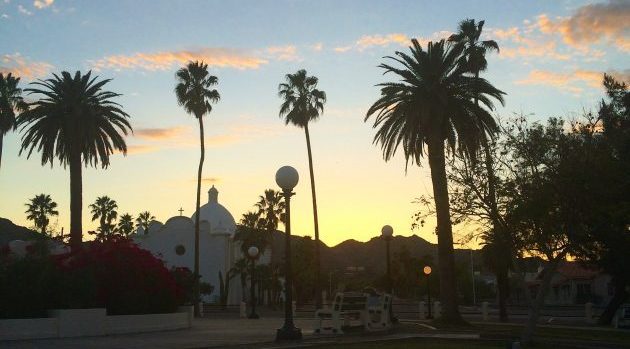A month or so ago we posted about Wylde IA’s graphics and marketing girl Harriet’s trip to the Arizona-Mexico border town mural project… Yesterday Harriet arrived in the tiny desert town Ajo – only 40miles from the border to start her giant mural. We will of course update on the mural project and event next week, but for now we’re exploring the curious town and the Ajo architecture.
Ajo, Arizona is a stunning place, where you might see a javelina walking down the street on your way down the street to a gallery opening, watch a Harris hawk circling above an outdoor yoga class, or get lost staring into an 1,100 foot deep hole in the earth. It’s a town of hidden gems and fascinating history. People call Ajo “a small town with a big backyard” with 12 million acres of desert land surrounding the little hamlet!
Ajo was built purely for it’s workers – it was a mining town, home to a thriving open-pit copper mine for over 70 years which closed suddenly in 1985. Though the mine closed the pit remains today which is a mile across and “as deep as the Empire State Building is tall” with a pool of bright turquoise water at the bottom.
Ajo’s town centre was designed in 1914 by a firm from Minneapolis appointed by the New Cornelia Copper Mine owner and to-be-AZ-senator John Greenway. The town was built to encourage pride in the miners who were to make Ajo their home. The civic structures are dominated by stunning Spanish-Colonial architecture. With most of the inhabitants leaving as the mine closed, it’s a strange sight to discover – elegant arches and regal bell towers, the focal point which is the Plaza and a short walk away, the grand Curley School which has now been converted into artist housing.
The town has been through it’s trial and tribulations – with rioting after the mine closure and abandonment of so many of the towns crucial faculties including the hospital and even the railway, even so Ajo is held in high regard due to its architectural beauty. The City Beautiful Movement highlighted Ajo as an important example of how beautification through architecture could promote and harness an increased quality of life which is something we preach and practice at Wylde IA. A well designed space is a productive space!






